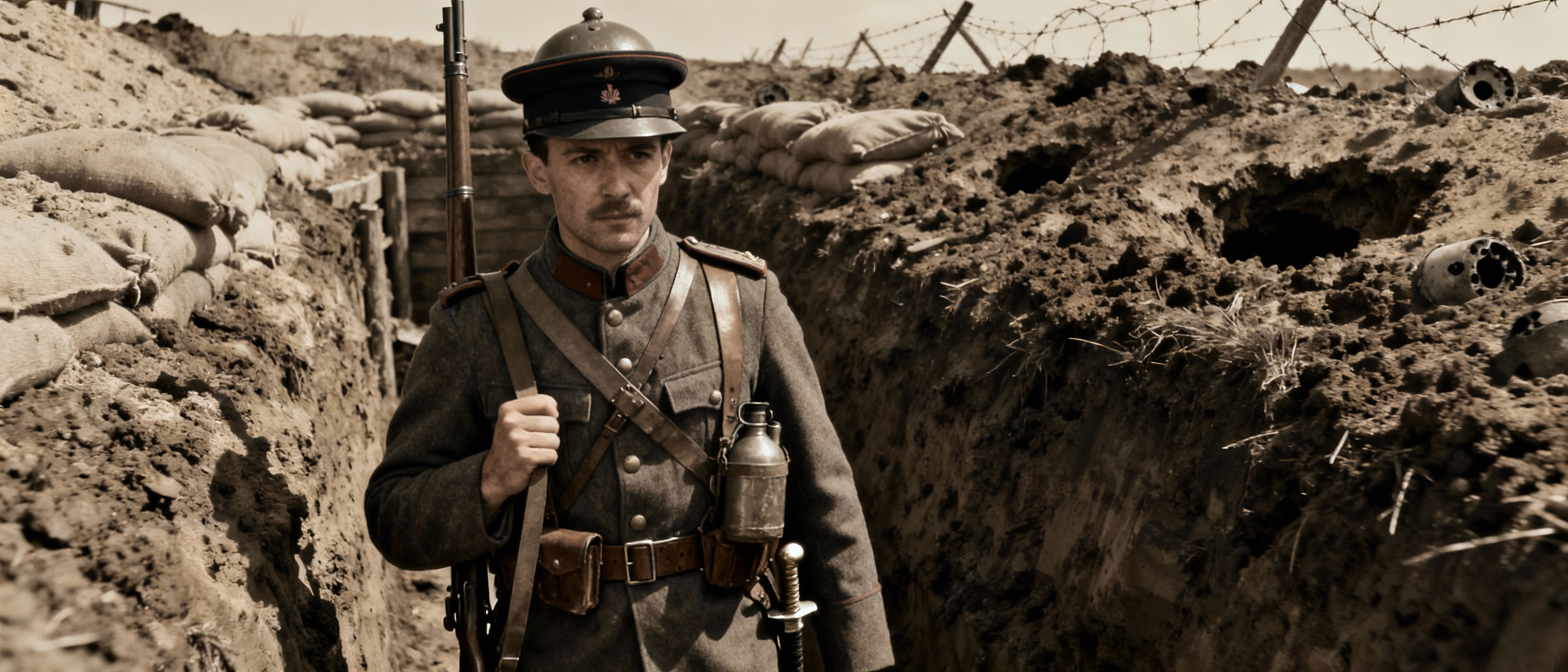
French Soldier Gear WW1: Challenges & Solutions
Published on Nov 17, 2025
WW1 French Soldier Gear: Challenges, Solutions & Legion Insights
Introduction
The First World War was a brutal conflict that saw millions of soldiers face unimaginable hardships on the battlefield. For French soldiers, their gear wasn’t just clothing and equipment—it was a lifesaver or sometimes a burden. The intense struggle with outdated uniforms and heavy loads added to the dangers they already faced from relentless combat. In this post, we'll dive into the gear worn by WW1 French soldiers, highlighting their problems, how certain solutions brought relief, and the unique roles of the French Foreign Legion and its sappers. Understanding the gear gives us a clearer view of the lives behind the statistics, including the staggering French deaths during the war.
Features of WW1 French Soldier Gear
Uniforms and Headgear
At the outbreak of WW1, French soldiers wore vivid uniforms with bright blue coats and red trousers that made them highly visible targets on the battlefield. This traditional attire, inherited from the 19th century, created major problems in early battles such as the Battle of the Frontiers, where casualties piled up due to the enemy easily spotting the troops. The iconic kepi worn by the French Foreign Legion, including those in sappers units, was initially bright red but was often covered with a blue-grey or khaki cover to reduce visibility. The Adrian helmet, introduced in 1915, was a turning point—offering much-needed protection against shrapnel and helping soldiers survive longer in trench warfare.
Personal Equipment
French infantrymen carried essential items in leather and canvas gear that dated back decades. Their kit usually included a leather belt with pouches for ammunition, a bayonet frog for the M1888 bayonet, a haversack, mess tins, and water bottles. The overall load could be heavy and cumbersome, causing discomfort during long marches and combat. Soldiers had to carry everything they needed, from food and water to tools and spare clothes, often weighing around one-third of their body weight.
Weapons and Tools
The main infantry weapon was the Lebel rifle, known for its reliability but complicated reloading system that slowed down the firing rate. French Foreign Legion sappers, specialized engineers within the Legion, carried additional equipment like explosives, pickaxes, and tools for trench construction and demolition. This specialized equipment was critical in clearing obstacles or fortifying positions under fire.
Pros & Cons of French Soldier Gear
AspectProsConsUniform Colors | Traditional pride and identification in early war | Bright colors made soldiers easy targets; visibility led to heavy losses
Adrian helmet | Effective protection against shrapnel; durable and iconic | Did not provide bulletproof protection but was better than cloth caps
Load carriage | Comprehensive kit covering essential survival needs | Heavy and cumbersome, limited mobility, caused fatigue
Lebel rifle | Reliable and accurate | Slow magazine reload due to tubular system; less effective in trench combat
Kepi (Legion) | Symbolic and functional with covers for camouflage | Not as protective as helmets initially; often replaced later
Sappers' tools | Allowed constructing trenches, demolition, and fortification tasks | Added extra weight and complexity to gear
Real-World Examples and Historical Case Studies
Heavy Casualties from Gear Issues
In August 1914, during the Battle of the Frontiers, the French Army’s traditional uniform colors caused disastrous visibility on the battlefield, leading to extremely high casualties. French deaths in WW1 totaled approximately 1.3 million military personnel, with many losses attributed to early tactical and equipment weaknesses that made soldiers easy targets for the enemy. This tragic reality forced changes in uniform regulations and equipment improvements during the war.
The French Foreign Legion’s Experience
The French Foreign Legion, including its sappers, was renowned for bravery despite facing the same equipment limitations. The Legion fought in critical battles like Verdun and the Somme and suffered heavy casualties. Legionnaires often wore the kepi with a cover or switched to helmets for better protection. Their elite sapper units were tasked with constructing trenches and clearing enemy obstacles, using specialized gear to survive and complete missions under fire. Stories of courage, such as bayonet charges after running out of ammunition, reflect the harsh realities the Legion endured and the vital role their equipment played in survival.
FAQs
Q1: Why were the French uniforms brightly colored at the start of WW1?
French military tradition valued bright uniforms for visibility and esprit de corps. However, this became a dangerous disadvantage as modern warfare favored camouflage and concealment.
Q2: What was the purpose of the kepi in the French Foreign Legion?
The kepi was a symbolic and practical headgear initially bright but later covered in muted colors to reduce battlefield visibility. It distinguished Legion soldiers and was part of their uniform identity.
Q3: How did the Adrian helmet improve soldier survival?
Introduced in 1915, the steel Adrian helmet protected soldiers from shrapnel wounds, a common injury in trench warfare, thus reducing fatal head injuries during combat.
Q4: What made the French Foreign Legion sappers unique?
Sappers were engineer troops responsible for trench construction, demolition, and clearing obstacles. They carried specialized tools and explosives, playing a crucial role in battlefield tactics.
Q5: How heavy was the average gear load carried by French soldiers?
French soldiers often carried a kit weighing up to one-third of their body weight, including weapons, ammunition, personal items, and survival gear, making movement challenging especially in trenches.
Conclusion and Key Takeaways
The gear worn by French soldiers in WW1 reflected both tradition and adaptation. Initially burdened by bright uniforms and outdated equipment, the French Army faced severe challenges that contributed to massive loss of life. Innovations like the Adrian helmet and the use of camouflage covers demonstrated solutions born from battlefield necessity. The French Foreign Legion, with its distinct kepi and sapper units, embodied resilience and adaptability, showing how specialized gear and roles could improve survival and operational success. Understanding this balance of problems and solutions offers insight into the lived experiences of French soldiers and honors their sacrifice amid the war's harsh realities.
